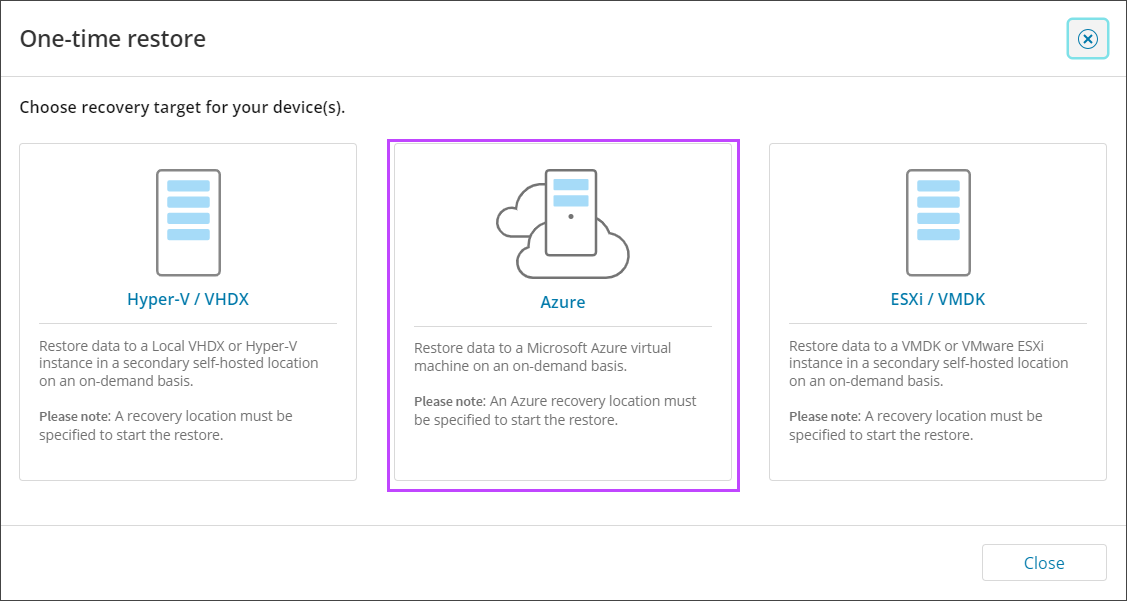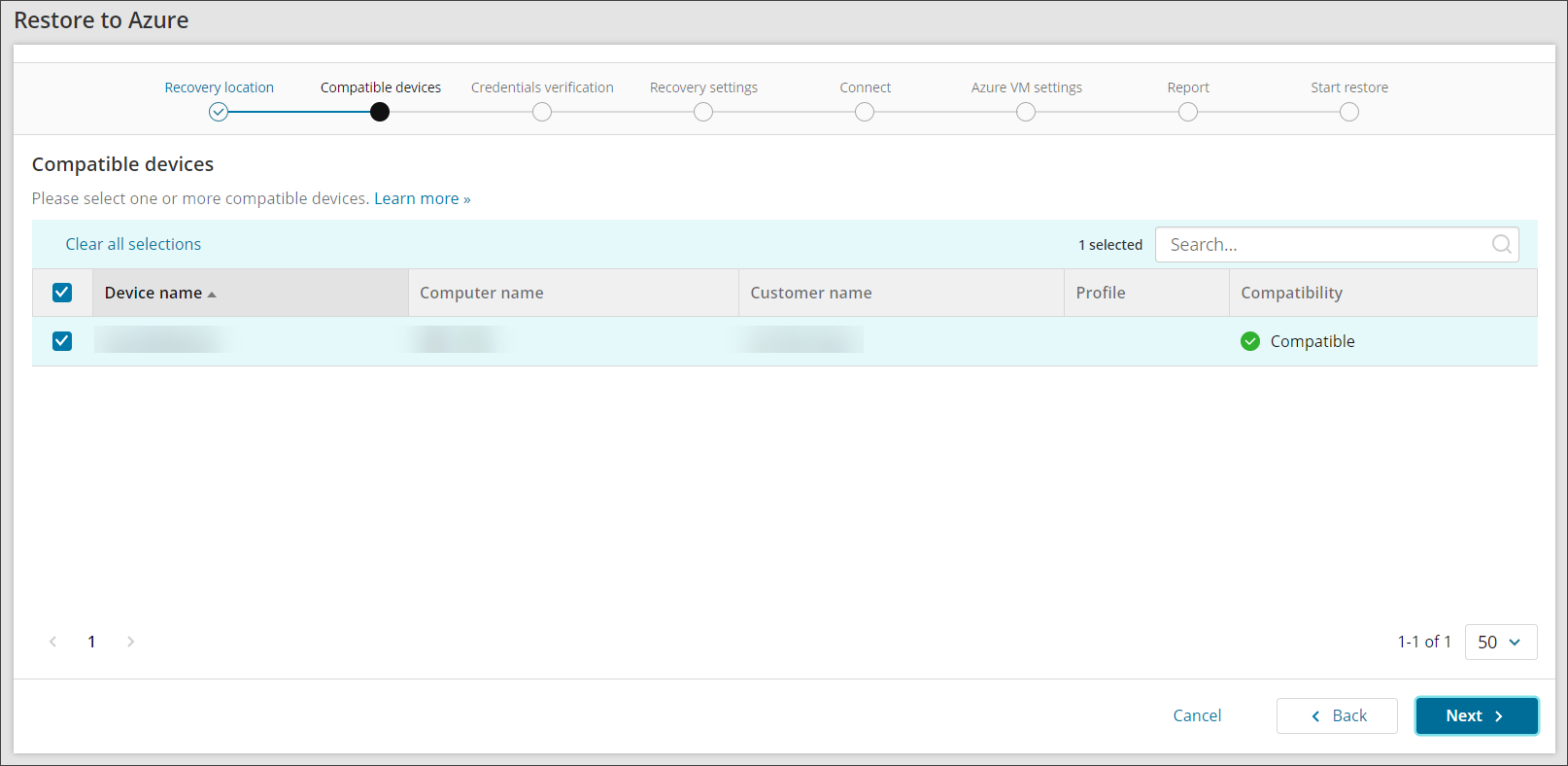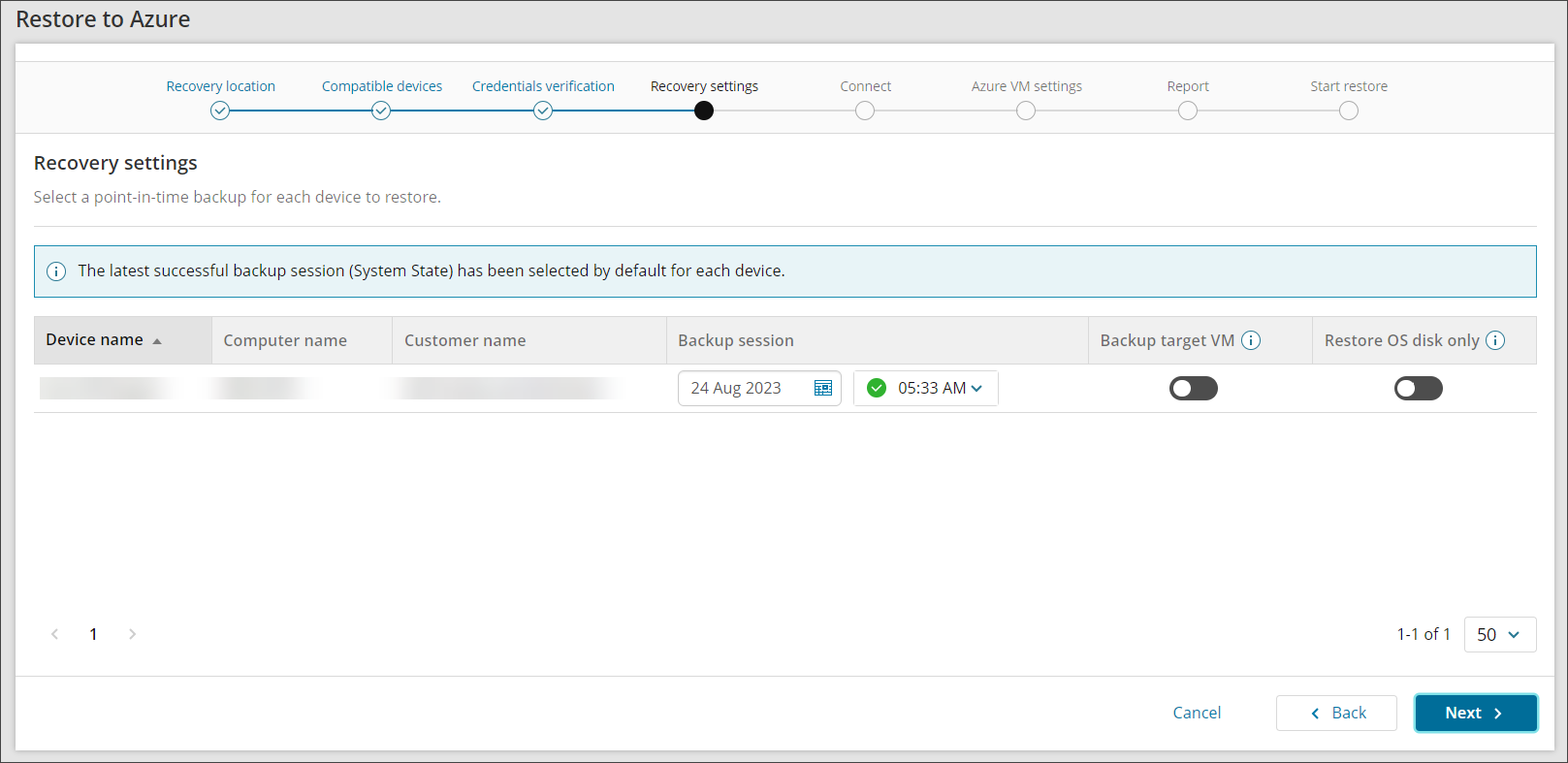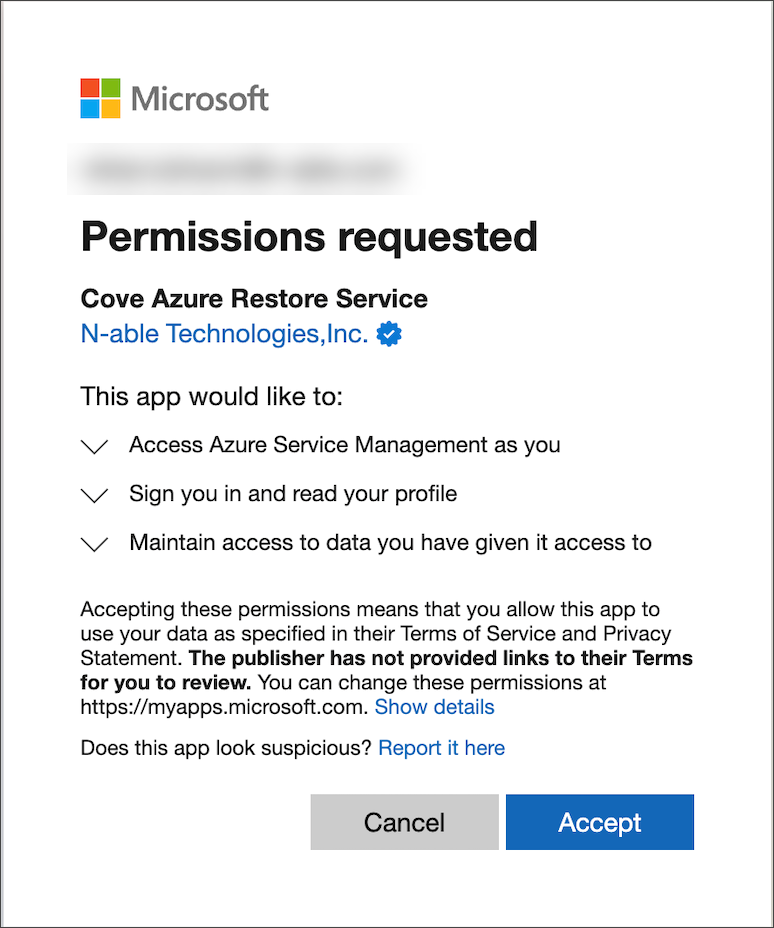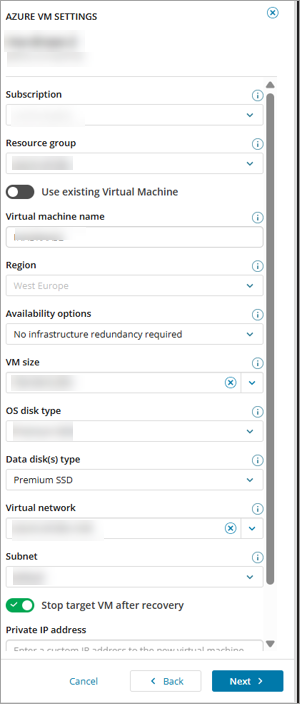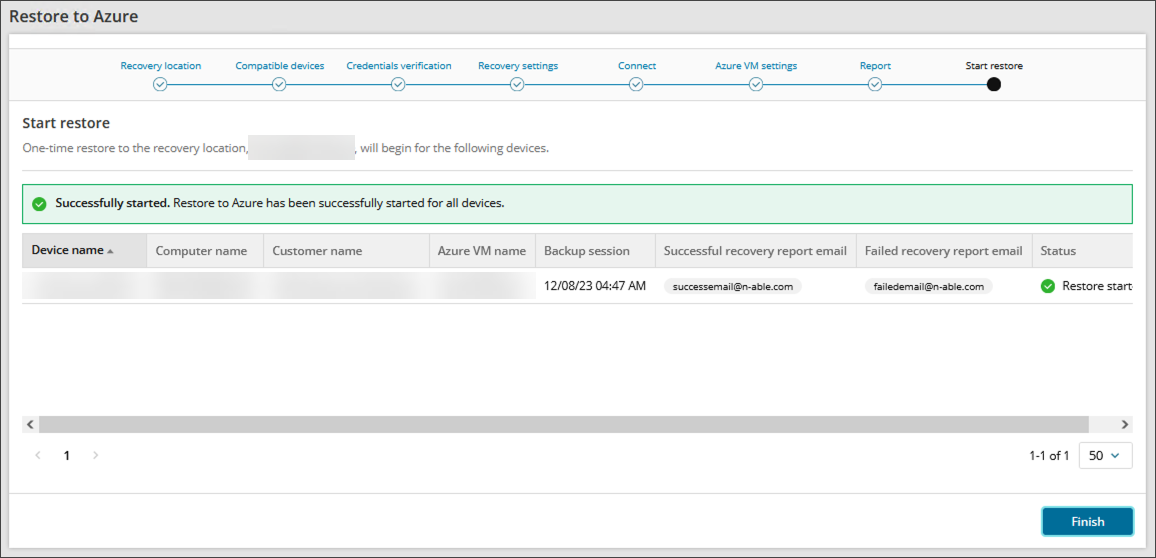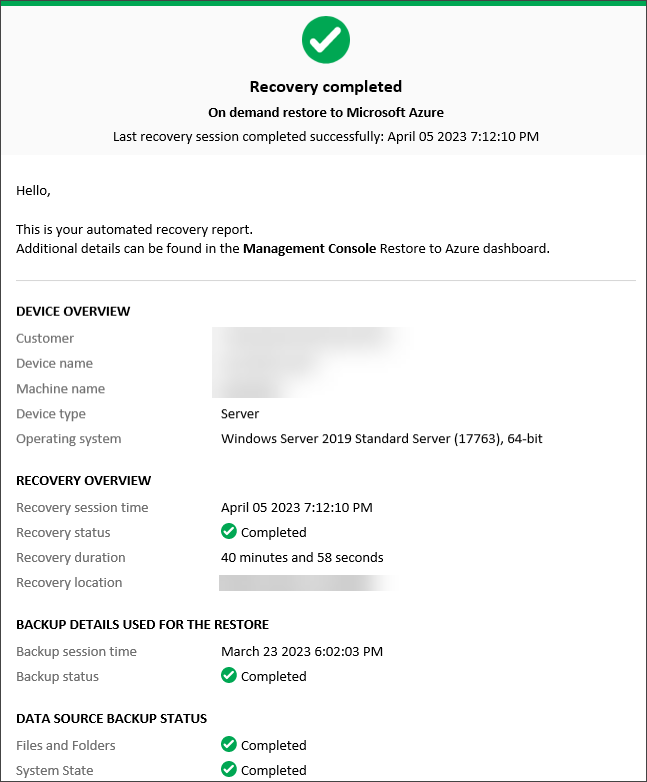Before starting a One-Time Restore to Azure, ensure you have checked all requirements and limitations, including setting up an Azure recovery location.
From Backup Dashboard
- Sign in to the Management Console using a SuperUser account.
- In the Backup Dashboard, tick the checkbox to the left of the device(s) to restore
- Click One-Time Restore
- Select the Azure target
- Select the Customer
- Select the Azure Recovery Location for the restore or click + Add recovery Location to follow the steps to create a new Azure Recovery Location
If adding a recovery location from here, you will be taken to the Add Azure Recovery Location wizard, where Azure will be automatically selected as the recovery type. Follow the Azure Recovery Location installation instructions from Step #4 onwards.
- Click Next
- Confirm compatibility of device(s) and click Next
- Enter the Encryption Key/Security Code or Passphrase for the device(s). This can be either:
- Private encryption key - Created by yourself when installing Backup Manager on the device. If you have lost the Encryption Key/Security Code for the device, you will need to Convert Devices to Passphrase-Based Encryption
- Passphrase encryption - These are generated on demand for automatically installed devices. You can find information on this here
If you are logged in as a security officer, this will be detected automatically.
- Click Next
- Select the date and time of the backup session to restore
During this step, all available sessions for all devices listed will be loaded in the backup session column. Please allow time for these to load, if the load of sessions fails, a message stating so will be displayed with a refresh button to try again.
- If you wish to protect the device according to its existing backup schedule, enable Backup target VM
If the Backup Target VM option is enabled for one or more devices, be aware that if the backup agent is still running in backup mode on the source VM, this will lead to corrupted backup data for both the source and target VMs.
- If you wish to skip all data drives, enable Restore OS disk only
Enabling Restore OS disk only will help to speed up restores as the only thing being restored is the Operating System
- Click Next
- Connect to Microsoft Azure by either:
- Allow permissions to the Azure user account to consent for apps access,
or;
-
-
Subscription
This cannot be changed as the subscription is set in the Recovery Location configuration
-
Resource Group
-
Use existing Virtual Machine
This is a toggle feature and should be kept ON only if you want to do restore to already existing selected resource group virtual machine. When ON, you can select a device which belongs to a Region of recovery agent from the existing list of the virtual machine names for the resource group devices and initiate restore. All the rest VM settings becomes hidden during restore taken from the choosen existing VM settings.
If you want to have new virtual machine as a result of restore, this toggle should be kept OFF. When OFF, you can enter the unique Virtual machine name in VM name field.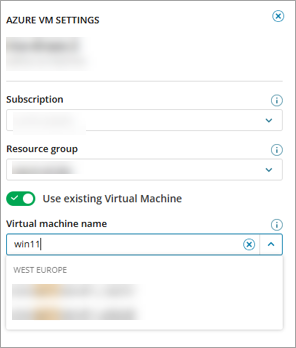
-
Virtual Machine name
-
Region
This cannot be changed as the subscription is set in the Recovery Location configuration
-
Availability options
-
VM size
If the VM size selected exceeds the size limit set within the Subscription, a warning will be displayed and you cannot proceed. You must either increase the regional vCPU quota on the Subscription, or decrease the VM size selected in the Azure VM Settings.
-
OS disk type
Set to Premium SSD to speed up the Azure restore. This can be changed in Azure later
-
Data disk(s) type
Set to Premium SSD to speed up the Azure restore. This can be changed in Azure later
-
Virtual Network
-
Subnet
The GatewaySubnet should not be selected for restores, as it is a special subnet within a virtual network (VNet) that is specifically reserved for the Virtual Network Gateway. Selecting that will cause a failure during the restore session.
-
Stop target VM after recovery
-
Private IP address
You can set custom Private IP Address for VM restored to Azure.
-
Assign NSG and public IP
-
- Click Next
- Click Next to progress to the Report window to enter one or more email addresses to receive a report when:
- The recovery is complete (Successful or Failed)
- The recovery was successful
- The recovery failed
Multiple addresses should be separated using a comma or semi-colon
If you do not want to add an email address to receive reports, click Skip this step
- To remove all branding from the reports, use the Remove Cove branding toggle per device, or above the device list to apply the changes to all devices in this window
- Review and confirm the restore details for each device and click Confirm
- Once the restore has been started, a green banner will be displayed and a notification in the top right-hand corner of the screen to confirm. Click Finish to close the restore wizard and return to the Dashboard
If you do not see the authentication page, make sure your browser is not blocking pop-up windows.
From One-Time Restore Overview
- Sign in to the Management Console using a SuperUser account.
- Navigate to the One-Time Restore overview by selecting Continuity > One-time Restore from the vertical menu on the left hand side
- Click One-time restore from the top bar
- The wizard will open to target selection window, follow the above steps from Step #4 onwards
Recovery Reports
When the device(s) assigned to the plan have Successful recovery report email or Failed recovery report email recipient address(es) configured, and once the test has completed, those recipients will receive the report in their email inbox.Here is an example report with Cove branding:
Here is an example without Cove branding:


